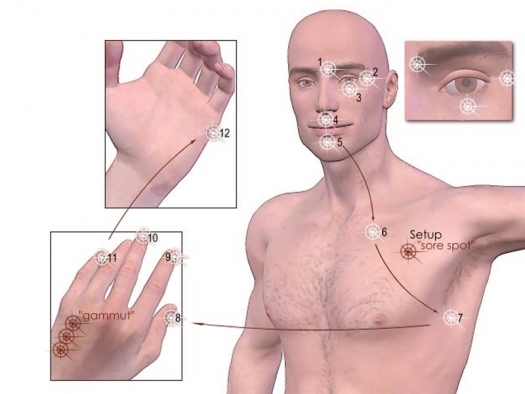EFTTappingPointsByMarcusWieman.jpg

Illustration by Marcus Wieman, Wikimedia Commons / CC BY-SA 3.0
Current chronic pain affects 20-33% of the American adult population (~50+ million adults) and represents a major health care crisis due its associated disabling physical and emotional problems (Gaskin & Richard, 2012), while resulting in healthcare costs up to $635 billion a year (Dahlhamer et al., 2016; Johannes et al., 2010).
Evidence from randomized controlled trials reveal lack of rigor in the quality of evidence reported on the effectiveness of physical therapy to treat and improve chronic pain (van Middelkoop et al., 2011)). In addition, although pharmacological treatments, specifically opioid prescriptions, have increased exponentially (Kenan et al., 2012) these drugs are often ineffective and incur a high risk for addiction and death (Abdel Shaheed et al., 2016). Similarly, meta-analytic evidence for use of cognitive behavioral therapy (CBT) to treat chronic pain as an adjunct to physical therapy, demonstrates limited to no incremental benefit (Hajihasani et al., 2019).
Due to this limited evidence and treatment void, several innovative mind-body interventions have emerged as potential treatments for chronic pain. Rationale for these psychotherapeutic approaches (provided at the body level) is indicated by the growing number of studies reporting acceptance of bodily sensations as an important mechanism in coping with pain and distress. One innovative non-pharmacological mind-body approach, Emotional Freedom Techniques (EFT), is an evidence-based brief intervention for anxiety, depression, phobias, and posttraumatic stress disorder.
EFT is a manualised evidence-based stress reduction technique that utilises elements of cognitive therapy with physical stimulation of acupressure points (Church, 2013a). Efficacy has been established for depression, anxiety, phobias, and posttraumatic stress disorder (PTSD, Church 2013b) and changes in biochemistry such as cortisol, blood pressure, immunity and an epigenetic potential to affect gene expression associated with PTSD symptomology has been established (Bach et al., 2019; Church et al., 2012; Church et al., 2018; Stapleton et al., 2020). Systematic reviews and meta-analyses have indicated large effects for anxiety, depression and PTSD (Church et al., 2018b; Clond, 2016; Nelms & Castel, 2016; Sebastian & Nelms, 2017). EFT is suggested to affect amygdala activity, and the hippocampus (memory), both of which play a role in the decision process when one decides whether something is a threat. EFT has also been shown to lower cortisol levels (Church et al., 2012; Stapleton et al., 2020) and deactivate neural mechanisms that trigger undesirable emotions or behaviours. It is therefore logical that reducing this limbic system hyperarousal will allow for greater prefrontal cortex activity.
The EFT process involves patients rating a concern (e.g., distressed feeling or discomfort) on a Subjective Unit of Distress scale (SUDS; Wolpe, 1973) zero to 10. A subjective measure of zero would represent an absence of distress and 10 would be the highest rating. Patients then vocalise their distress in a setup statement accompanied by an acceptance statement while physically tapping with two fingers on the side of the hand point (see Figure 1). For example, “Even though I have this worry about xxxx, I accept I feel this way”. The patient then manually stimulates (taps) the acupressure points in Figure 2, while stating a reminder phrase from the setup statement (usually the main concern e.g., “this worry”). The process is typically repeated until the patient’s SUDS rating is low.
Initial research investigating EFT for chronic pain (Stapleton et al., 2015) offered a brief intensive 4-hour treatment program to participants in a persistent pain program.
Over the 4-hours there was a significant decrease in the severity (–12.04%, p = 0.044) and impact (–17.62%, p = 0.008) of participants’ pain, and a significant improvement in their overall psychological distress (–36.67%, p < 0.001). There was also a significant improvement in participants’ depression (–29.86%, p = 0.007), anxiety (–41.69%, p < 0.001), and stress (–38.48%, p = 0.001). A significant association was found between pain and psychological distress. A significant overall main effect of time was found at six-months’ follow-up.
Current Research
2020 research has now examined a 6-week EFT treatment program for chronic pain, delivered in two formats: self-paced (online) and facilitator-led (delivered live online due to COVID). Both versions had a waitlist condition. Participants (n=120 to date) were randomly allocated to either option via computer randomisation.
Preliminary results for everyone who underwent EFT intervention (both types of EFT delivery) indicate:
- A significant positive correlation between ACE (adverse childhood experiences score) and presence of PTSD symptoms
- A significant positive correlation between ACE and Quality of Life score, such that those participants with higher ACE scores had lower quality of life scores
- A significant number of participants who initially met the diagnosis of Somatic Symptom Disorder, Depression, Anxiety, and Panic Disorder did not meet this after the EFT intervention
- A significant improvement occurred after the EFT treatment for all participants’ quality of life
- A significant reduction in pain severity occurred after EFT treatment for all participants
- There was no significant difference or change in PTSD symptoms or well-being after EFT intervention because the participants did not suffer with PTSD symptoms to start with.
For the group who were waiting EFT treatment (waitlist), there were no significant differences in any measures during this time before treatment. Their depression symptoms actually significantly worsened, and they also had a significant decline in well-being.
We then examined the differences between the self-paced version of the program against the facilitator-led sessions. For the self-paced group:
- There was a significant decrease in the percentage of participants who met the diagnosis of Somatic symptom disorder, Depression, Anxiety, and Panic disorder after EFT intervention
- There was a significant improvement in quality of life after EFT treatment
- There was a significant reduction in pain severity after EFT treatment
- There was no significant different for PTSD symptoms or well-being for the self-paced group after EFT intervention because the participants did not suffer from PTSD symptoms to start with.
For the facilitator-led group, participants achieved the same results as the self-paced group in terms of not meeting diagnosis, and having a significant reduction in pain, however there were no significant improvement in quality of life of PTSD symptoms and wellbeing.
It appeared the self-paced version achieved a slightly better outcome and indicated this mode of delivery may be suitable for those who cannot attend in person sessions. A cautionary note here is that the sample sizes to date are different and the results will be rea analysed when the trial is complete. Six- and 12-month follow-up is occurring for those who have completed the trial, and in 2021 a sub group will undergo fMRI scanning pre and post EFT treatment, to examine neural changes after EFT treatment. This group will also be assessed for vagal tone/efficiency in partnership with Dr Stephen Porges and the Kinsey Institute Traumatic Stress Research Consortium, Indiana University (USA). This investigation will examine the impact of EFT on vagal tone for chronic pain patients.
References
Abdel Shaheed C., Maher C.G., Williams K.A., Day R., & McLachlan A.J. (2016). Efficacy, Tolerability, and Dose-Dependent Effects of Opioid Analgesics for Low Back Pain: A Systematic Review and Meta-analysis. JAMA Internal Medicine, 176:958-68.
Bach, D., Groesbeck, G., Stapleton, P., Sims, R., Blickheuser, K., & Church, D. (2019). Clinical EFT (Emotional Freedom Techniques) Improves Multiple Physiological Markers of Health. Journal of Evidence-Based Integrative Medicine, 24. https://doi.org/10.1177/2515690X18823691
Church, D. (2013a). The EFT Manual. Energy Psychology Press: USA.
Church, D. (2013b). Clinical EFT as an evidence-based practice for the treatment of psychological and physiological conditions. Psychology, 4(08), 645. doi: 10.4236/psych.2013.48092
Church, D., Yount, G., & Brooks, A. (2012). The effect of emotional freedom techniques on stress biochemistry: a randomised controlled trial. The Journal of Nervous and Mental Disease, 200(10), 891–896. doi:10.1097/NMD.0b013e31826b9fc1
Church, D., Yount, G., Rachlin, K., Fox, L., & Nelms, J. (2018a). Epigenetic Effects of PTSD Remediation in Veterans Using Clinical Emotional Freedom Techniques: A Randomized Controlled Pilot Study. American Journal of Health Promotion, 32(1), 112–122. doi: 10.1177/0890117116661154
Church, D., Stapleton, P., Yang, A., & Gallo, F. (2018b). Is Tapping on Acupuncture Points an Active Ingredient in Emotional Freedom Techniques? A Systematic Review and Meta-analysis of Comparative Studies. The Journal of Nervous and Mental Disease, 206(10), 783–793. doi:10.1097/NMD.0000000000000878
Clond, M. (2016). Emotional Freedom Techniques for Anxiety A Systematic Review With Meta-analysis. Journal Of Nervous And Mental Disease, 204(5), 388–395. doi: 10.1097/NMD.0000000000000483
Dahlhamer J, Lucas J, Zelaya C, et al. (2016). Prevalence of chronic pain and high-impact chronic pain among adults — United States. Morbidity and Mortality Weekly Report 2018; 67:1001–6.
Gaskin D.J., & Richard, P. (2012). The economic costs of pain in the United States. The Journal of Pain: Official Journal of the American Pain Society, 13:715-24.
Hajihasani A., Rouhani M., Salavati M., Hedayati R., & Kahlaee A.H. (2019). The Influence of Cognitive Behavioral Therapy on Pain, Quality of Life, and Depression in Patients Receiving Physical Therapy for Chronic Low Back Pain: A Systematic Review. The Journal of Injury, Function, and Rehabilitation, 11:167-76.
Johannes C.B., Le T.K., Zhou X., Johnston J.A., & Dworkin R.H. (2010). The prevalence of chronic pain in United States adults: Results of an Internet-based survey. The Journal of Pain: Official Journal of the American Pain Society, 11:1230.
Kenan K., Mack K., & Paulozzi L. (2012). Trends in prescriptions for oxycodone and other commonly used opioids in the United States, 2000-2010. Open Medicine; 6:e41-7.
Nelms, J., & Castel, L. (2016). A Systematic Review and Meta-Analysis of Randomised and Nonrandomized Trials of Clinical Emotional Freedom Techniques (EFT) for the Treatment of Depression. Explore: The Journal of Science and Healing, 12(6), 416–426. doi: 10.1016/j.explore.2016.08.001
Sebastian, B., & Nelms, J. (2017). The Effectiveness of Emotional Freedom Techniques in the Treatment of Posttraumatic Stress Disorder: A Meta-Analysis. Explore: The Journal of Science and Healing, 13(1), 16–25. doi: 10.1016/j.explore.2016.10.001
Stapleton, P. B., Chatwin, H., Sheppard, L., & McSwan, J. (2017). The lived experience of chronic pain and the impact of brief Emotional Freedom Techniques (EFT) group therapy on coping. Energy Psychology: Theory, research, practice, training, 8(2), 18-28. https://doi.org/10.9769/EPJ.2016.8.2.PS
Stapleton, P., Crighton, G., Sabot, D., & O'Neill, H. M. (2020). Reexamining the effect of emotional freedom techniques on stress biochemistry: A randomized controlled trial. Psychological Trauma: Theory, Research, Practice, and Policy, 12(8), 869-877. https://doi.org/10.1037/tra0000563
van Middelkoop M., Rubinstein S.M., Kuijpers T., et al. (2011). A systematic review on the effectiveness of physical and rehabilitation interventions for chronic non-specific low back pain. European Spine Journal, 20:19-39.
Wolpe J. (1973). The Practice of Behavior Therapy. 2nd ed.


